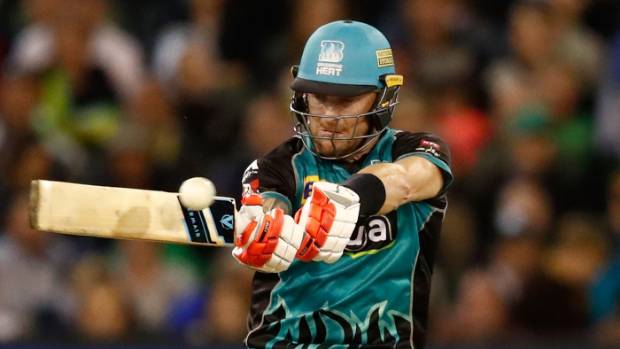No shenanigans, pure batting ecstasy: Brendon McCullum
It’s April 8, 2012. RCB have been sent into bat by KKR. De Kock, fails to fire, and is sent back to the dug-out. Next up is Virat Kohli. For some reason, perhaps stranger than Bermuda triangle mystery, he can hardly put bat to ball. The wicket is slow to bat on and the bowlers feel they hold a lottery ticket as they shine the white-ball. On the other end, however, one man dances down the track to Vinay Kumar, lifting him over long on for a six. He then drives Chawla for a bludgeoning boundary. It’s the same bloke who began the inning with a glitzy chip off his legs to deep square leg boundary. Brendon McCullum could well write a thesis on how to shake up bowlers in no time at all.
Little surprise then that on the same Eden Garden wicket where a Virat Kohli failed to fire and de Kock never quite looked set, McCullum struck a typical 27 ball 43.
Brendon McCullum’s greatness
For a batsman who, by virtue of skyrocketing strike rates seems perpetually in a hurry, every iota of time spent in watching those muscular pulls, ferocious cuts and mighty heaves are totally worthy of time spent in cricketing recreation. Quite savoury then, that the former Kiwi captain has become only the second batsman ever to go past 9000 T20 runs.
With only Gayle in front of him and possibly a linear trajectory of many bedazzling talents in the trail- Kohli, Pollard, Bravo, De Villiers, Maxwell, Miller, Dhoni- there’s finally a line where McCullum’s name fronts the list. Even as he may hardly care about milestones or monikers. After all, trading in the realm where flings with appreciation define success doesn’t quite define the ball-smashing New Zealander.
Finest Test, ODI innings that bore a T20 signature of brutality
It never has. It never will. Even as some of McCullum’s greatest Test and ODI innings have borne the typical feisty signature of a wham-bam T20 approach of batting. Which another batsman would you care to remember, maybe other than a Sehwag, who sent bowlers packing in his very final inning at a strike rate that seemed like a worrisome blood pressure reading at 183? Since when have Test innings begun to depict T20 strike rates? Only in the reign of one of cricket’s most underrated masters of unorthodoxy could such feats of grandeur be accomplished?
You felt that in his 145 off 79 at Christchurch, McCullum was the artist with a tool of destruction in hand, not a paintbrush. Few batsmen have been as cold with the bat as affectionate with their warmth in a smile. We may never see a more destructive batsman who seemed unmoved amid scenes of savagery and yet so cheery at being given the chance to compete at the highest level?
When you think of McCullum, you think of every tiny fragment of effort that he lent to changing New Zealand’s status quo: anointing them the tag of dangerous when they were just considered ‘black sheep’ in world cricket. And yet, here was a man who remained readily coy in hiding behind the grandeur of personal efforts letting others bathe in the glow of showmanship. Martin Guptill. Kane Williamson and now, Trent Boult.
The road ahead
But the common thread that brought New Zealand together akin to a plank that forms the base for great construction was always the man who remained sagely aloof of his own greatness. When he belted what might actually be his greatest ODI inning- 59 of 26 against South Africa- at Auckland in the fateful day of Protean mourning (ICC 2015 world cup), most remembered not McCullum’s fiery fifty that came at a strike rate of 226. But Grant Elliot who struck the winning runs. Always the bridesmaid, never the groom. McCullum readied the present-day Kiwi side, soldiering it like a vicious hitter who dug the grave of many who dared the might of those brawny powers. With 2-3 years of competitive cricket in him, it remains to be seen if Gayle’s mighty 10,000 run mountain can be scaled by the Kiwi right-hander using quintessential T20 tropes: see the ball… hit the ball. Not sure if McCullum would run after glories.

